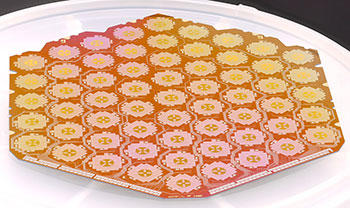
NIST sensor chip to be installed in an upgraded camera for the Atacama Cosmology Telescope in Chile to search for signs of cosmic inflation.
Cool instruments—literally—made by the National Institute of Standards and Technology (NIST) contributed to the media's top science stories of 2014.
More than a dozen science magazines highlighted the BICEP2 telescope's observation of faint whirls called b-modes in the cosmic microwave background—announced as evidence of rapid inflation in the first moment of the universe. NIST's role in the project was technological: The BICEP2 camera relies, in part, on the extraordinary signal amplification made possible by NIST's superconducting amplifier chips.
Although the discovery has since been questioned, with the signals attributed at least partly to galactic dust, the media still considered the story important. For example, Scientific American named the BICEP2 discovery as No. 4 of its Top 10 Science Stories of the Year: Big Bang Gravitational Waves—or Not. The magazine concluded: "Either way, the hubbub has illustrated not just the trial and error that is at the heart of the scientific method but also the way the universe keeps finding new ways to throw curve balls at those who try to figure it out."
In addition, Science News ranked BICEP2 as No. 2 of its 25 Top Science Stories of 2014: Dust obscures possible gravitational wave discovery. Wired magazine listed BICEP2 as No. 3 in its list of The Best and Worst in a Tumultuous Year for Science. New Scientist called it one of the most awesome stories of the year. Discover magazine hailed the discovery as No. 5 of the 100 Top Stories of 2014.
Astronomy magazine listed BICEP2 as No. 5 of the Top 10 Space Stories of 2014. The story was also one of Io9's Biggest Scientific Breakthroughs of 2014 and one of Space.com's Biggest Astronomy Stories of 2014. Nature's year-end roundup, 365 Days: 2014 in Science, called BICEP2 a "big dust bust," while Science called it a runner-up in the year's bad news. And the story was mentioned in Science Friday's 2014 Science Year in Review, the American Physical Society's Notes from the Editors: Highlights of the Year and IFLScience's From Comet Chasing To Gravity Waves: 2014 In Six Science Stories.
BICEP2 was also popular overseas: It was one of the BBC's science news highlights of 2014 and The Guardian's Weird and wonderful: the most popular science stories of 2014.
As scientists around the world continue to evaluate the role of dust in the BICEP2 results, other telescopes also are searching for evidence of cosmic inflation, and NIST instruments may enable future discoveries. NIST quantum sensors and/or amplifiers are deployed on about 10 telescope cameras, including several that are, or will be searching for b-mode patterns (see accompanying photo).
Another NIST advance made Discover's Top 100 list at No. 80: Tinkering with the Cosmos's Constants. NIST physicists used their watt balance apparatus to refine the value for the Planck constant, used in many scientific calculations, including, perhaps, the future definition of the kilogram. The magazine noted: "These new values won't change how we see the universe, but they may make our understanding more precise, and eventually that much deeper."
In other top story lists, Discovery News's Top10 Techs that Exploded in 2014 cited a University of Geneva experiment using NIST detectors that "teleported" the quantum state of a light particle 15.5 miles through fiber, a record distance for quantum teleportation. Optics & Photonics News named JILA's quantum droplet, a discovery led by a NIST physicist, as among the most exciting optics research of the year. And Biophotonics magazine named as one of its top stories of the year an enhanced NIST instrument that enables high-speed chemical imaging of biological tissues.

